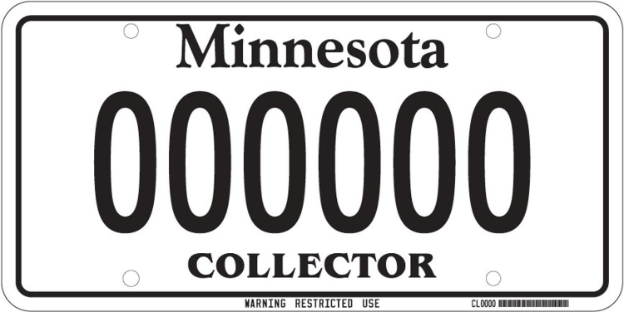
The Truth About Minnesota Collector Plates
Why would you want a collector, pioneer, classic, street rod, or military license plate? To save money on annual tab fees. The tab fee you pay every year is a tax for operating your vehicle on public roads, which is based on the age and value of the vehicle. The tab fees start out high and decrease as the vehicle ages. Collector plates, on the other hand, have a one-time tax fee and don’t require yearly tabs after that point. Each plate has its own specific standards, but all must meet some basic requirements to be eligible for collector plates. The vehicle must be at least 20 years old or of such rarity that they were made in limited quantities. You must own a vehicle registered with regular taxable plates that is available for daily transportation needs. That's really the basic requirements for collector plates. See Minnesota Statute 168.10 for more information.
My buddies and/or the DMV people say that "You can only drive my vehicle with collector plates to parades, or car shows, or the repair shop, and you can only drive them a limited amount of miles per year." FALSE! This is a common misconception about collector plates. The idea of limited annual mileage or restricted travel use is likely from collector insurance If you insure the vehicle as a collector item, which typically can cost less than regular insurance, some insurance companies may implement use restrictions to minimize their exposure to claims. Collector plates do not require you to carry collector insurance. Although the plates do say "Warning Restricted Use", the state statute only requires you to have another vehicle registered normally and available for daily use. Minnesota Statute 168.10 subd. 1c (c) "The owner shall also prove that the owner also has one or more vehicles with regular license plates." There aren't any restrictions on the use of the vehicle in the eyes of the state other than you can't use it for daily transportation needs or commercial use. For example, I own a 2001 ¾ ton Chevy Suburban that I use for towing, hauling people, hauling stuff, and snow plowing. It is not my daily driver, and it’s insured normally. In 2021, I moved this vehicle over to collector plates, which cost me about $60. Since 2021, this vehicle has traveled to Montana, Utah, and all over the Midwest towing vehicles and hauling stuff. I use this vehicle as much as I need to without concern, which is all perfectly legal.
Custom collector plates are also available for an additional cost. It can be fun to personalize your special ride with custom plate numbers. Just check with your local DMV to see if your special plate numbers or wording are available. Be ready to explain what the plate means because they will ask. One catch to collector plates is if the vehicle is sold, the state of MN will tax the purchaser a flat tax fee of $150 plus the transfer fees. Just keep that in mind if you are purchasing a vehicle that is currently registered as a collector vehicle. Minnesota likes their tax.
If you own more than one vehicle, and some of those vehicles are more than 20 years old, it can save you money by transferring them over to collector plate vehicles. There is also a storage advantage to collector plates since they don’t expire. These vehicles can be stored outside without the local authorities giving you a hard time about storing unlicensed vehicles. Take advantage of this great program offered by the state and save some money. The details we are discussing are for the state of Minnesota, but many states have similar programs available for older vehicles. Each state has specific requirements to be eligible. Do a little research online and read through the state statutes for clarification. It will be time well spent and could save you a bunch of money.
Aaron Bjorklund